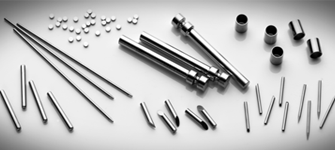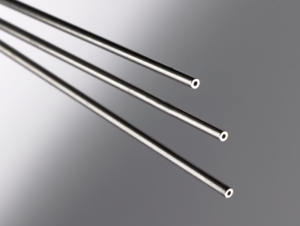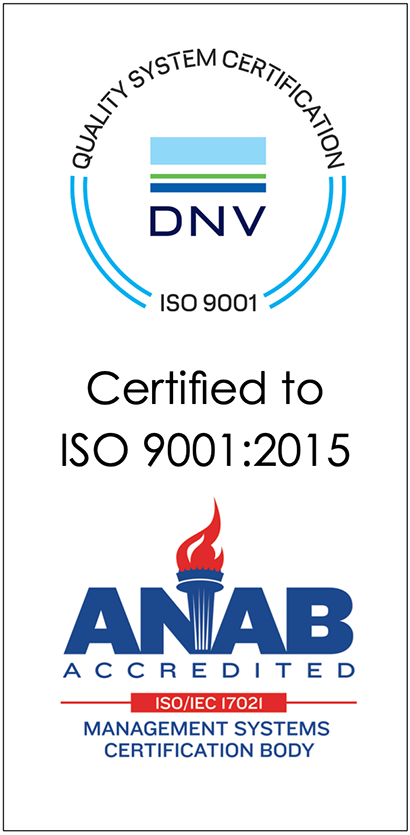The Myths of Plastic vs. Metal Tubing for Medical Devices
As medical technology advances and new minimally invasive procedures are developed, medical device designers must come up with medical tubing products that are:
- Ever smaller in diameter
- More sophisticated and yet still cost-effective
Although metal medical tubing has been a mainstay of the medical device industry for many years (and for good reason), the use of plastic medical tubing is growing. Literally thousands of resin compounds have been developed to yield specific physical characteristics, such as strength, flexibility, pushability, and lubricity — expanding the design options for tubing in new medical devices.
For example, thin plastic tubing is used in catheters for a wide range of cardiovascular, urological, gastrointestinal, neurovascular, and ophthalmic applications. Plastic medical tubing in varying levels of stiffness (depending on the application) is commonly used for drainage, administration of fluids or gases, access by surgical instruments, and other tasks.
Yet, while plastic is perceived to be both flexible (if not literally) and cheap for use in many medical tubing applications, there are a number of myths about plastic and reasons why it may not be a better choice than metal medical tubing.
Let’s take a look at six of the myths about plastic medical tubing.
Myth 1: Plastic medical tubing is biocompatible and
non-toxic.
Well . . . sometimes. Consider polyvinyl chloride (PVC) polymer, which has a long history in medical tubing and the medical device industry due to PVC’s versatility and cost.
The FDA and other health organizations have identified risks associated with di-2-ethylhexyl phthalate (DEHP), a common plasticizer (softener) that is often added to PVC. Since PVC is hard and brittle at room temperature, DEHP is added to increase PVC’s flexibility for uses such as medical tubing.
The problem is that DEHP can leach out into solutions that come in contact with the plastic tubing, in applications such as:
- IVs and blood infusion
- Nutrition feeding
- Peritoneal dialysis
- Cardiopulmonary bypass (CPB)
- Extracorporeal membrane oxygenation (ECMO)
- Hemodialysis.
We are all exposed to small levels of DEHP in everyday life. However, individuals who come into more frequent contact — such as chronically ill patients who are exposed through multiple medical procedures — may be subject to a number of adverse effects, such as endocrine disruption, liver toxicity, and other issues.
While there are alternatives to DEHP, its use in medical PVC is still common. Medical tubing manufacturers can move toward alternative, non-DEHP plastics, but these materials are typically more expensive than PVC.
So, while many plastics can be biocompatible and non-toxic, we have to wonder: As new plastics are developed and others are used over the long term, what as-yet-unknown risks will be uncovered?
Myth 2: Disposable plastic medical tubing is the way
to go.
It’s true that plastics are practical for single-use medical tubing applications, such as catheters made from PVC or silicone and designed to be used once and thrown away. Using disposable devices can also help to curb the spread of infection, which is both a safety concern and a cost issue for hospitals, surgical centers, and other healthcare providers.
However, according to the Healthcare Plastics Recycling Council, U.S. healthcare facilities generate about 14,000 tons of waste per day — and about 20% to 25% percent of that waste can be attributed to plastic packaging and plastic products.
Therefore, it is vital to also consider the cost of adding even more “disposability” to the mix, in the form of medical tubing and other devices made of plastic.
Besides the cost and impact of disposing of tons of material every year, the environmental footprint also extends to the manufacturing process. For example, for every pound of product made in the U.S., 32 pounds of waste are created during manufacturing.
In addition, the transportation of all the products a hospital purchases adds to plastic’s carbon footprint. (You can read more about hospital sustainability here.)
Clearly, the amount of medical tubing and other plastic waste generated by healthcare facilities is an environmental and sustainability concern. Incineration of plastics adds pollutants to the air; even when plastics are properly disposed of, they remain in the environment for a very long time.
So, how wise is it to add more plastic — a material specifically designed NOT to break down — in the form of disposable medical tubing?
Myth 3: Plastic medical tubing can be reused as easily as metal medical tubing can.
Some people may counter disposal concerns with the proposal that plastic medical tubing can, like metal tubing, be resterilized and reused. But bear in mind that when medical tubing is reused, the material must be able to maintain its desired characteristics — such as its rigidity, strength, compatibility, or biological or chemical resistance — under repeated exposure to disinfectants, sterilization, and routine cleaning processes.
Depending on the specific material characteristics, metal medical tubing can be resterilized using a number of methods, including:
- Autoclaving
- Dry heat
- Gamma irradiation
- Chemical disinfectant
However, plastic tubing may not be able to stand up to those same methods and maintain its desired characteristics.
For example, the preferred method for catheter device sterilization uses electron beam (e-beam) or gamma irradiation. These high-energy methods eliminate the use of some popular fluoropolymers in catheter assemblies, such as fluorinated ethylene propylene (FEP) or polytetrafluoroethylene (PTFE).
In turn, this can compromise the performance of the finished devices, since as yet there is no good substitute plastic with all the performance attributes of FEP or PTFE.
Myth 4: Plastic medical tubing is as strong as metal.
Some high-performance polymers can provide metal-comparable levels of strength and rigidity at ambient temperature. However, compared with other types of medical tubing, metal is still stronger and more robust, making it well suited for applications requiring:
- A high degree of structure
- High tensile modulus (stiffness)
- High-pressure fluid flow
So, despite the widespread use of plastics, certain medical device applications may require tubing made from metal. For example, metal medical tubing generally holds its shape and is a superior choice for an application such as a biopsy needle that must go through bone.
High-quality stainless steel or titanium alloy tubing is used in a wide range of surgical and dental instruments, where the metal tubing excels in meeting required strength-to-weight ratios, as well as microbiological corrosion resistance and fatigue life.
For added strength, metal medical tubing can be constructed in different shapes — such as circular, oval, rectangular, square, or customized — or in multiple concentric layers.
Plastic medical tubing can be reinforced with a layer of braided metal wire for added strength and torque transmission. However, the process is fairly labor intensive and adds to the cost.
In addition, performance can vary depending on the quality of the bonding between the layers of the plastic tubing. What’s more, it can be more challenging to maintain a clean, nondeformed end cut when cutting lengths of braided plastic tubing.
Myth 5: Plastic medical tubing is more cost-effective
than metal.
With cost savings a major driver in healthcare, plastics do offer the ability to make medical tubing and single-use devices that are disposable, eliminating the cost of resterilization after use.
In addition, plastics can be cheaper to process than metals. This can allow designs to incorporate long, thin geometries produced via injection molding, such as for tubes commonly used in catheters, ventilator tubes, and other medical devices in which flexibility is a must.
However, while plastic parts may be cheap to make once large-scale manufacturing begins, the cost to make a mold can be thousands or even tens of thousands of dollars in initial outlay, depending on the type of mold. That can make prototyping and small runs prohibitively expensive.
Metal medical tubing continues to be a cost-effective choice in many devices requiring precise tolerance, resistance to certain solvents or fluids, or other functional characteristics.
And while plastic might sometimes be a good option for some medical tubing, it is important to also remember that plastic cannot be cut as exactly as metal can be — an important consideration wherever lives may depend on the accuracy of a tube.
6: Plastics are the future.
With apologies to Mr. McGuire of The Graduate, plastic does not have a monopoly on innovation in medical devices
For instance, plastic stents have been promised for many years, including a “fully bioresorbable vascular scaffold” made of a plastic that can be implanted and then reabsorbed by the body when it is no longer needed. However, so far that idea has not yet fulfilled its promise and remains a work in progress.
Meanwhile, the use of metal medical tubing continues to evolve. For example:
- In vascular stents, stainless steel is being replaced by cobalt chromium alloy or platinum chromium alloy and platinum group metals (PGMs), which are highly compatible with the human body and resistant to high temperatures and corrosion.
- Tungsten metals in various forms have been used in medical tubing for devices utilized to perform minimally invasive laparoscopic and endoscopic surgical procedures.
Even as the use of plastic medical tubing grows, the properties of metal tubing make it a viable alternative for the fabrication of many medical devices. As the devices get smaller and procedures become more sophisticated, new and innovative applications for metal medical tubing will continue to emerge alongside developments in plastic.
Weigh the Pros and Cons Before Choosing
Of course, every tubing material has pros and cons that need to be weighed against the end use and production goals for your specific medical tubing application. With the many medical tubing options available today — both in metal and in plastic — the right materials supplier can help you choose the best option based on your medical device application and budget.
As medical technology advances, Metal Cutting will continue to be here to provide tubing and other parts that meet the needs of the medical device industry. As a precision metal fabricating company, our expert capabilities include very tight tolerance cutting, grinding, lapping, and polishing of all metals for medical device applications.
We also provide secondary operations such as bending, angle cutting, and pointing and slotting of small diameter tubes, wires, and rods. In addition, tungsten and molybdenum products, such as wire, ribbon and rod, are available.
To learn more about specifying precision metal tubing for your medical device needs, download a free copy of our white paper, Metal Tubing in the 21st Century: Who Needs It? The Future of Innovation in Medical Devices.






